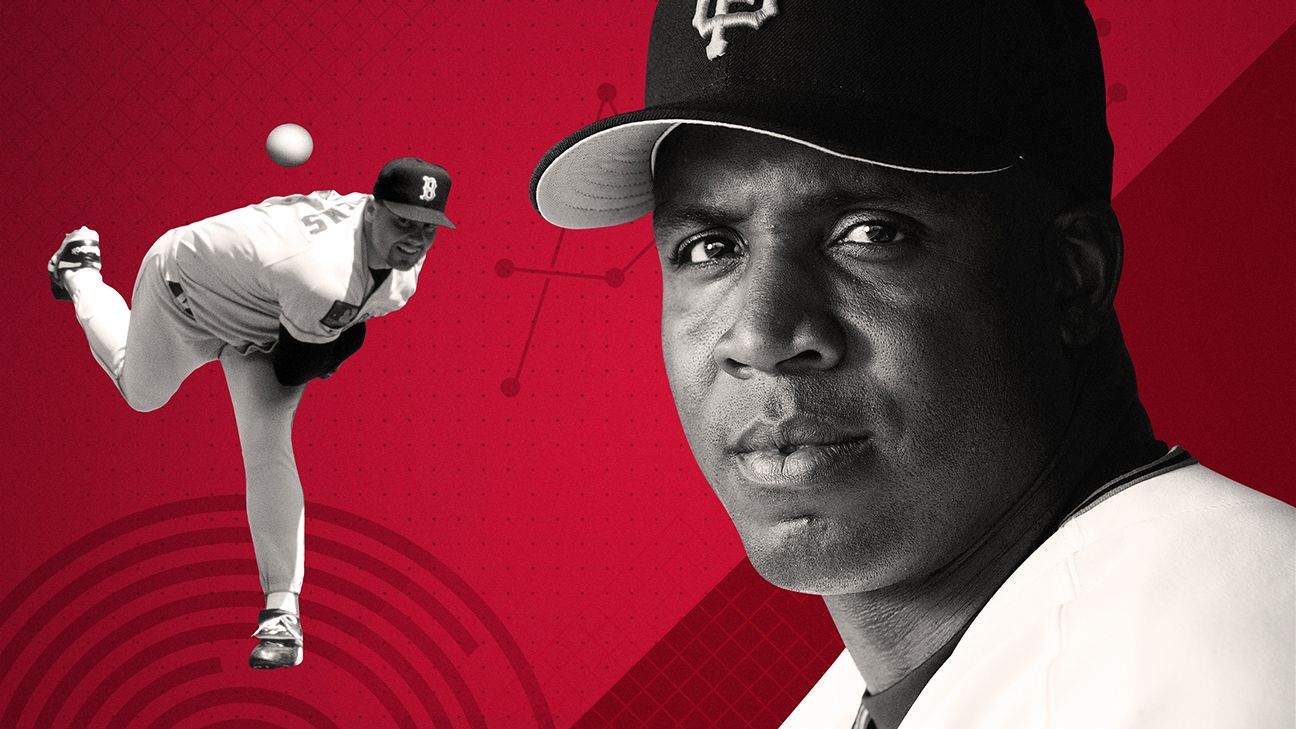
THIS IS IT for Barry Bonds and Roger Clemens, the end of the road on the steroid-driven debate about their Baseball Hall of Fame worthiness. Or unworthiness.
It's their last of 10 years of eligibility with voters from the Baseball Writers' Association of America, and ballots are due by the end of this month. If Bonds and Clemens don't get at least 75% of votes this time, they'll need help from a select committee to join legends like Babe Ruth, Willie Mays and Cy Young, let alone their own contemporaries, superstars like Ken Griffey Jr. and Randy Johnson.
By the numbers, both would have been first-ballot Hall of Famers; Bonds for being among the greatest players to don a baseball uniform, and Clemens for a 24-year career that generated 354 wins and seven Cy Young Awards. But enough voters have decided that the players' relationships with performance-enhancing drugs are disqualifying.
So we wondered: Just how much did their presumed drug use affect their career numbers?
How many home runs would Bonds actually have hit in 2001? That's the first year he used a concoction of drugs obtained through the Bay Area Laboratory Co-Operative (BALCO) -- and the season he demolished the single-season home run record by blasting 73. Or, what about Clemens' remarkable 2004 season? That's when, in the year he turned 42, Clemens went 18-4, struck out 218 batters and posted a 2.98 ERA on the way to his seventh Cy Young Award.
Meet baseball stats guru Dan Szymborski, the creator of the ZiPS projection system. In the simplest terms, the system (endorsed by MLB.com and explained here) uses past performance and trends on how performance degrades with age to predict a player's future performance. ESPN asked him to project Bonds' and Clemens' career stats from the season each is believed to have started using PEDs -- 1999 for Bonds and 1998 for Clemens.
Things look startlingly different in the Bonds/Clemens cases when analyzed this way:
Bonds' home run totals
Instead of hitting 73 home runs in 2001, the ZiPS projection suggests Bonds would have hit only 23 that year, plus or minus a couple. And where he actually hit 209 homers during the four seasons (2001 to 2004) he used the BALCO concoction, he was projected to hit just 66 during those four years.
According to ZiPS, where should Bonds be on the all-time home run list? Rather than the king, with 762, the projection has him at 551 career homers -- placing him at No. 15, below Manny Ramirez (well, that's another discussion) and above Mike Schmidt. It's also worth noting that the projection suggests Bonds would have played one fewer season than he did.
Bonds' WAR stats
While no stat says "Barry Bonds" more than the home run, WAR speaks in far more powerful ways. The goal of WAR is to give the most complete sense of a player's value to his team, and it's perhaps the best piece of data to compare the greatness of one player to the next. It basically estimates how many wins a player is worth to his team vs. an average replacement player.
Bonds, buoyed by an astronomical run during his steroid-fueled years, wound up with a career WAR of 164.4 (using FanGraphs data), placing him No. 2 on the all-time list, barely behind Babe Ruth and well ahead of his godfather, Willie Mays. Before 1999, the year he started using PEDs, Bonds' highest WAR for a single season was 10.5, in 1993, and that was his only double-digit season. But from 1999 on, he posted four seasons in double digits, including two above 12 and then 11.9 in 2004 -- the year he turned 40.
The ZiPS system projects a far different arc. Instead of 11.9 in 2004, ZiPS predicts Bonds with a WAR of 1.7. And during the four-year BALCO stretch, instead of totaling 47.3, he would have been expected to total 14.2. For his career, ZiPS projects Bonds' WAR total at 128.7 -- dropping him from No. 2 of all time to No. 9, just ahead of Stan Musial.
Bonds' OPS+ stats
According to OPS+, which measures a player's ability to get on base and hit for power and normalizes for the effect of various parks, Bonds was unquestionably one of the game's great players during the first half of his career, when he had seven consecutive seasons of 170 or higher.
But after he started PEDs, he became otherworldly, particularly once he connected with BALCO. In those four seasons, his OPS+ was 259, 268, 231 and 263 -- giving him three of the five highest seasons ever, surpassed only by Negro Leagues legend Josh Gibson. Bonds is No. 4 on the all-time career list, with a 182 average OPS+.
But according to ZiPS, those cartoonish four seasons would have been replaced with 156, 144, 115 and 95; and his career OPS+ would have settled at 153, placing him tied for 30th.
Clemens' win totals
As for Clemens, ZiPS has a similarly deflating effect on his numbers if you predict beyond 1998, when it's believed he started using PEDs. The first thing worth noting is that ZiPS projects Clemens would have played three fewer seasons, with his career ending after 2004. That was the year when he turned 42 and went 18-4, with a 2.98 ERA, 214⅓ innings pitched and 218 strikeouts. ZiPS instead projects that final season would have looked far more mundane: 8-5, 3.35 ERA, 113 innings pitched and 105 strikeouts.
While the relevance of wins and losses has become debatable in the era of empirical analysis, Szymborski believes it's useful in dissecting Clemens' numbers. Clemens finished with 354 wins -- 141 of which came after the date when Clemens' former personal trainer, Brian McNamee, testified he first injected the pitcher with PEDs. ZiPS projects Clemens was likely to have won only 85 games during that stretch -- leaving him with a career total of 298, just short of the magic number of 300 that has long been a guaranteed ticket to Cooperstown. That total would drop him from ninth on the career list to 24th, just ahead of Tommy John (288).
Clemens' innings-pitched totals
Perhaps the most notable Clemens stat is innings pitched. The numbers reveal what a durable force he remained well into his late 30s and early 40s. He turned 35 during the 1997 season and tossed 264 innings; thereafter, he had six more seasons with 200-plus innings pitched, including 2005 when, at the age of 43, he threw 211⅓ innings, had a 1.87 ERA and struck out 185 hitters.
ZiPS projects he would have reached 200 innings only once more in his career and would have wound up with 689 fewer career innings pitched -- taking him from 15th on the all-time list to 33rd, just ahead of Frank Tanana.
Clemens' WAR totals
Although Clemens' real-life WAR numbers weren't as dramatic as Bonds', he amassed enough powerful numbers over those last 10 seasons of his career to become the all-time leader among pitchers with 133.7, just ahead of Cy Young. Over that stretch, he amassed 46 of that total, including nearly 11 during the three seasons ZiPS projects he never even would have been playing.
ZiPS says that instead of an 8.2 in 1998, he would have had 4.9 and then continued a steady decline from there. In the end, ZiPS projects his WAR would have been 111.3, taking him from all-time leader to fourth, just below Greg Maddux and above Randy Johnson.
What does all this really mean?
The thing about Bonds and Clemens is that, unlike so many other players, they seemed to get better -- at least for a few years -- as they got older, defying the slow, steady decline that typically leads to retirement. And so, their career numbers became bloated: Bonds with his 762 career homers, 2,558 walks (688 intentional) and a .607 slugging percentage; Clemens with his nearly 5,000 innings pitched, 4,672 strikeouts and more than 700 games started.
The stats are at least in part -- and perhaps a large part -- a byproduct of the performance-enhancing drugs it's believed they used during the second half of their careers. Based on reporting and court records, Bonds began using PEDs before the 1999 season. McNamee has testified that he began injecting Clemens before the 1998 season.
It should be noted: Bonds has said he didn't know that the substances he took were steroids or other PEDs. Clemens flat-out denied to Congress in 2008 that he ever took any such drugs. Both men were charged in separate federal perjury cases; Bonds was found guilty on one count of obstruction of justice, though the guilty verdict was later overturned, and Clemens was found not guilty in his court case.
Szymborski is the first to admit that his projection system is not an exact science -- maybe something akin to predicting the weather -- and that the drugs can't account entirely for the sizable differences between the projections and the players' real, larger-than-life numbers. Yes, modern-day players are in far better shape than their predecessors, working out harder and more consistently (though PEDs actually are part of that equation in some cases). Players' careers are lasting longer, as they recover faster from injuries and benefit from a more scientific approach to the game. And, of course, Bonds and Clemens faced an untold number of opponents who used PEDs, too.
With those caveats, however, the ZiPS system has proved startlingly accurate. To demonstrate, Szymborski took 139 players who had at least 502 plate appearances in 2015, then compared their real numbers in five categories over the next six seasons to what the projection model spit out. The accuracy of the results surprised even Szymborski. For example, when comparing their real-life home run totals with projected homers (he normalized by using actual plate appearances, thus accounting for injuries, anomalies, etc.), the "average" miss was about two per season. The average miss on batting average was 13 points, and on OPS it was 36 points.
Hall of Fame voters conceivably could take all this data and toss it into the mental algorithms they've concocted to decide the fates of Bonds and Clemens. Maybe they'd look at the ZiPS projections and find new justifications for admitting or rejecting the two men. In truth, though, it seems pretty clear numbers have not been the issue with voters who have denied Bonds and Clemens entry. It's the reported cheating. That's why we saw this exercise as having much more potential to reveal what their careers and legacies might have looked like if they'd followed a more predictable path. No, it's not exact science, but, again, the weather is a fairly forecastable thing. And so in this case, ZiPS suggests that while Bonds and Clemens were great no matter what, they would hold vastly different places in baseball's record book.
ESPN researcher John Mastroberardino contributed to this report.















 Phone: (800) 737. 6040
Phone: (800) 737. 6040 Fax: (800) 825 5558
Fax: (800) 825 5558 Website:
Website:  Email:
Email: 






